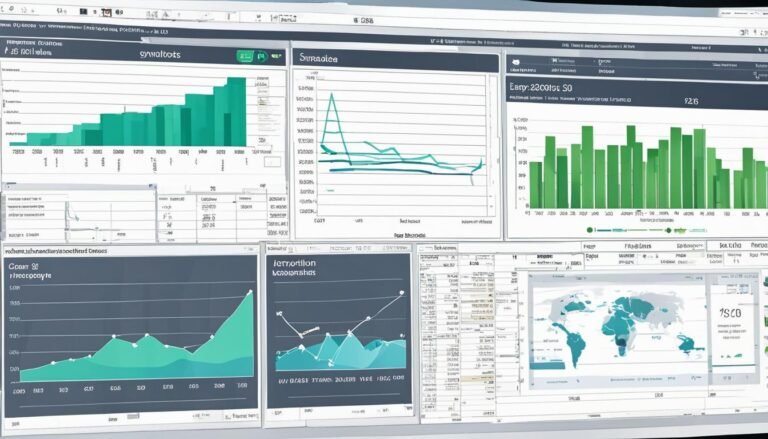Financial Case Study Analysis
In the fast-paced world of finance, through the labyrinth of data can be akin to finding a needle in a haystack. However, with the right tools and methodologies, you can extract invaluable insights that drive strategic decision-making and foster business growth.
By diving into a financial case study analysis, you'll uncover not just numbers on a page but a narrative that reveals the true heartbeat of a company. Understanding this narrative can be the key to a treasure trove of opportunities and mitigating potential risks.
Key Takeaways
- Evaluate financial health for informed decisions.
- Identify areas for improvement and performance enhancement.
- Compare metrics with industry peers for benchmarking.
- Analyze trends, risks, and make data-driven strategic decisions.
Importance of Financial Analysis
Why is financial analysis essential for making informed business decisions?
Financial analysis plays a critical role in providing a thorough understanding of a company's financial health. Through financial health assessment, businesses can evaluate their current financial standing, identify areas of improvement, and make strategic decisions to enhance overall performance.
By conducting performance benchmarking, companies can compare their financial metrics with industry peers or competitors to gain insights into their relative position and identify areas where they may need to catch up or where they excel.
Profitability analysis is another key aspect of financial analysis that helps businesses assess the efficiency of their operations and identify opportunities to increase profitability. By analyzing various financial ratios and metrics, organizations can pinpoint areas where they can cut costs, optimize resources, or explore new investment opportunities to drive growth and enhance their financial performance.
Identifying Key Financial Indicators
To effectively assess a company's financial health and performance, it's fundamental to identify key financial indicators that provide valuable insights into its operational efficiency and profitability. Key ratios play an essential role in this assessment, offering a snapshot of various aspects of a company's financial status.
Here are four key financial indicators to contemplate when evaluating a company's financial health:
- Profit Margin: This ratio indicates the company's profitability by showing how much profit it generates for each dollar of revenue.
- Return on Investment (ROI): ROI measures the return on an investment relative to its cost, providing insight into the efficiency of capital deployment.
- Debt-to-Equity Ratio: This ratio reveals the proportion of debt and equity a company is using to finance its assets, indicating its financial leverage.
- Current Ratio: The current ratio assesses the company's ability to cover its short-term liabilities with its short-term assets, reflecting its liquidity position.
Analyzing Financial Trends
When analyzing financial trends, you'll focus on:
- Revenue growth analysis
- Expense trend evaluation
These two vital points provide essential insights into the financial health and performance of a company. By examining these trends, you can identify patterns, make informed decisions, and drive strategic actions.
Revenue Growth Analysis
Analyzing revenue growth trends provides valuable insights into the financial performance and potential future success of a company. When examining revenue growth, consider the following:
- Revenue Forecasting: Utilize historical data and market trends to predict future revenue streams accurately.
- Competitive Analysis: Compare your revenue growth to industry competitors to evaluate your market position.
- Market Segmentation: Identify which market segments are driving revenue growth for targeted strategies.
- Pricing Strategy: Assess the impact of pricing changes on revenue growth and adjust strategies accordingly.
Expense Trend Evaluation
In evaluating financial trends, closely monitor and analyze expense trends to guarantee the company's operational efficiency and cost management practices. By examining expense reduction strategies and utilizing trend forecasting techniques, you can pinpoint areas where costs can be optimized.
Analyzing expense trends over time allows you to pinpoint any spikes or dips, enabling you to take proactive measures to maintain financial stability. Look for patterns in expenses and compare them to revenue trends to safeguard a balanced financial strategy.
Implementing effective cost control measures based on these analyses can lead to improved profitability and sustainability for the organization. Keep a keen eye on expense trends as they can provide valuable information for strategic decision-making and long-term financial health.
Evaluating Potential Risks
To assess the potential risks associated with the financial case study, identify and prioritize key risk factors that may impact the analysis. When evaluating potential risks in the financial case study, consider the following:
- Risk Assessment: Begin by conducting a thorough risk assessment to identify all potential threats to the financial analysis process. This includes market risks, regulatory risks, and operational risks that could impact the outcomes.
- Mitigation Strategies: Once risks are identified, develop effective mitigation strategies to address each risk factor. This may involve diversifying investments, implementing hedging strategies, or establishing contingency plans to minimize potential negative impacts.
- Financial Health Evaluation: Evaluate the overall financial health of the organization under study to understand its resilience to different risk scenarios. This will help in determining the level of risk tolerance and the ability to withstand financial shocks.
- Scenario Planning: Engage in scenario planning to simulate different risk scenarios and assess their potential impact on the financial analysis. By considering various outcomes, you can better prepare for uncertainties and make informed decisions.
Uncovering Insights for Decision Making
Explore the data to unearth key insights important for informed decision-making in the financial case study analysis. By delving into financial metrics and adopting an analytical approach, you can extract valuable decision insights with significant financial implications. Through a meticulous examination of the data points and trends, you can identify patterns, outliers, and correlations that provide a deeper understanding of the financial landscape under scrutiny.
Analyzing financial metrics such as revenue growth, profit margins, return on investment, and cash flow patterns can offer vital insights into the financial health and performance of the entity in question. These insights can guide decision-making processes, helping you make informed choices based on concrete data rather than intuition or speculation.
Strategic Guidance Through Analysis
When analyzing financial case studies, strategic planning tips serve as important pillars for decision-making processes.
By leveraging data-driven insights, you can navigate complexities and uncertainties with more clarity.
Strategic guidance through analysis empowers you to make informed choices that align with your long-term objectives.
Strategic Planning Tips
Utilize a structured approach to strategic planning by integrating key performance indicators with market trends analysis. When making strategic decisions and financial forecasts, consider the following tips:
- Set Clear Goals: Define specific and measurable objectives aligned with the overall business strategy.
- Evaluate Competitor Strategies: Analyze competitors' moves to anticipate market shifts and stay ahead.
- Regularly Review KPIs: Monitor key performance indicators to track progress towards goals and adapt strategies accordingly.
- Stay Agile: Be prepared to adjust plans swiftly in response to changing market conditions or unforeseen challenges.
Data-Driven Decision Making
To better align your strategic planning efforts with data-driven decision making, integrate key performance indicators with thorough market analysis for enhanced strategic guidance. Data analysis plays an important role in informing your decision-making process by providing valuable insights into market trends, customer behavior, and financial performance.
By utilizing data-driven approaches, you can identify opportunities for growth, pinpoint areas for improvement, and make informed decisions that are backed by evidence. Effective decision making hinges on the ability to interpret and leverage data effectively.
Incorporating data analysis into your strategic planning allows you to stay agile, responsive to market changes, and proactive in addressing challenges. Embracing a data-driven mindset empowers you to navigate complexities with confidence and make strategic choices that drive success.
Driving Business Success
Implementing a strategic approach to operations is imperative for driving business success in today's competitive market environment. To achieve this, consider the following key strategies:
- Efficiency Enhancement: Streamlining processes and workflows can lead to performance improvement and cost reduction. Implementing automation and optimizing resource allocation can help maximize output while minimizing expenses.
- Market Analysis: Conduct thorough market research to identify opportunities for growth and profit maximization. Understanding consumer needs and competitor strategies can provide insights for developing effective business plans.
- Customer Relationship Management: Building strong relationships with customers can enhance loyalty and drive repeat business. Implementing customer feedback mechanisms and personalized services can lead to increased customer satisfaction and retention.
- Employee Development: Investing in employee training and development can boost productivity and morale. Engaged and skilled employees are more likely to contribute positively to the company's overall success.
Practical Tips for Evaluation
To evaluate the effectiveness of the key strategies discussed in driving business success, practical tips for evaluation can provide valuable insights into the overall performance and impact of these initiatives.
Evaluation techniques play an important role in understanding the outcomes of implemented strategies. Conducting case studies can aid in appraising real-world applications of these strategies, offering practical insights into their success or areas needing improvement.
Utilizing financial metrics such as return on investment (ROI), profitability ratios, and cash flow analysis can provide a quantitative understanding of the impact on the financial health of the business. Decision support tools can assist in making informed choices based on performance analysis.
Benchmarking strategies against industry standards can offer a comparative perspective to gauge the effectiveness of the implemented strategies. By applying these practical evaluation methods, you can gain a thorough understanding of the success and areas of development within your business strategies.
Conducting Thorough Analysis
Conducting a thorough analysis involves delving deep into the data to extract meaningful insights that can drive informed decision-making and strategic planning within your business. To make sure your analysis is exhaustive and effective, consider the following steps:
- Utilize Industry Benchmarks: Compare your financial data against industry standards to identify areas of strength and weakness. This benchmarking process can provide valuable context for evaluating your company's performance.
- Perform Competitor Analysis: Analyze your competitors' financial statements and key performance metrics to understand how your business stacks up against industry rivals. This insight can help you identify opportunities for improvement and areas where you excel.
- Identify Key Financial Ratios: Calculate and analyze important financial ratios such as profitability ratios, liquidity ratios, and leverage ratios. These ratios can offer valuable insights into your business's financial health and performance.
- Consider Trend Analysis: Examine historical financial data to identify trends and patterns that can help you forecast future performance and make more informed decisions. Trend analysis can provide valuable insights into your business's trajectory and potential areas for growth.
Conclusion
As you navigate the financial landscape, remember that analysis is your compass, guiding you through the complexities of numbers and trends.
Just like a skilled chef tasting a dish to adjust the seasoning, your financial analysis allows you to fine-tune your decisions for success.
Trust in the power of data to steer you towards your goals and guarantee your financial journey is as smooth as a well-balanced recipe.







